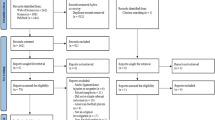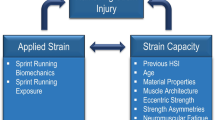Abstract
Objective
The study aimed to compare the concentric and eccentric muscle performance of the hip abductor and adductor muscles at a high angular velocity in football players with osteitis pubis and healthy players.
Methods
A total number of 32 male football players with osteitis pubis and 20 healthy footballers were tested using an isokinetic dynamometer at a speed of 180°/s. Hip abductor and adductor peak torque/body weight, time to peak torque, acceleration, and deceleration times produced during concentric and eccentric muscle contraction modes were measured using a Biodex dynamometer.
Results
Football players with osteitis pubis demonstrated a significantly higher time to peak torque, acceleration, and deceleration times (p < 0.05); however, when compared to healthy athletes, there was no significant change in muscle strength.
Conclusion
The present study showed that football players with osteitis pubis had a reduction in neuromuscular reaction. Therefore, the reaction time of these muscles is critical, and the reduction could result in magnified stresses and/or poorly distributed loads across the musculotendinous structure of the anterior pelvis, which presumably could lead to the development of osteitis pubis. Incorporate findings of the current study in clinical practice could afford critical information when evaluating the hip muscles in football players with osteitis pubis, for pre-screening, enhancing the rehabilitation programs, and guiding the decision of returning to sports after injury.


Similar content being viewed by others
References
Rodriguez, C, Miguel, A, Lima, H, Heinrichs, K (2001) Osteitis pubis syndrome in the professional soccer athlete: a case report. J Athl Train 36:437
Mandelbaum, B, Mora, SA (2005) Osteitis pubis. Oper Tech Sports Med 13:62–67
Brukner P (2012) Brukner & Khan's clinical sports medicine: McGraw-Hill North Ryde
Batt, ME, McSHANE, JM, Dillingham, MF (1995) Osteitis pubis in collegiate football players. Med Sci Sports Exerc 27:629–633
Johnson, R (2003) Osteitis pubis. Curr Sports Med Rep 2:98–102
Fricker PA, Taunton JE, Ammann W (1991) Osteitis pubis in athletes. Sports Med 12:266–279
Holt MA, Keene JS, Graf BK, Helwig DC (1995) Treatment of osteitis pubis in athletes: results of corticosteroid injections. Am J Sports Med 23:601–606
Pham DV, Scott KG (2007) Presentation of osteitis and osteomyelitis pubis as acute abdominal pain. Perm J 11:65
Ekstrand J, Ringborg S (2001) Surgery versus conservative treatment in soccer players with chronic groin pain: a prospective randomised study in soccer players. Eur J Sports Traumatol Relat Res (Testo stampato) 23:141–145
Mohammad WS, Abdelraouf OR, Elhafez SM, Abdel-Aziem AA, Nassif NS (2014) Isokinetic imbalance of hip muscles in soccer players with osteitis pubis. J Sports Sci 32:934–939
Mohammad WS, Elsais W (2018) Abdominal/adductor strength imbalance in soccer players with osteitis pubis. J Men’s Health 14:e33–e40
Pontaga I (2003) Muscle strength imbalance in the hip joint caused by fast movements. Mech Compos Mater 39:365–368
Pelegrinelli AR, Guenka LC, Dias JM, Bela LFD, Silva MF, Moura FA, Brown LE, Cardoso JR (2018) Isokinetic muscle performance after anterior cruciate ligament reconstruction: A case-control study. Int J Sports Phys Ther 13:882
Chen W-L, Su F-C, Chou Y-L (1994) Significance of acceleration period in a dynamic strength testing study. J Orthop Sports Phys Ther 19:324–330
Cozette M, Leprêtre P-M, Doyle C, Weissland T (2019) Isokinetic strength ratios: Conventional methods, current limits and perspectives. Front Physiol 10:567
Schlumberger A, Laube W, Bruhn S, Herbeck B, Dahlinger M, Fenkart G, Schmidtbleicher D, Mayer F (2006) Muscle imbalances–fact or fiction? Isokinet Exerc Sci 14:3–11
Wilk KE, Romaniello WT, Soscia SM, Arrigo CA, Andrews JR (1994) The relationship between subjective knee scores, isokinetic testing, and functional testing in the ACL-reconstructed knee. J Orthop Sports Phys Ther 20:60–73
Maciel DG, Dantas GAF, Cerqueira MS, Barboza JAM, Caldas VVDA, de Barros ACM, Varela RR, Magalhães DH, de Brito Vieira WH (2020) Peak torque angle, acceleration time and time to peak torque as additional parameters extracted from isokinetic test in professional soccer players: a cross-sectional study. Sports Biomech 1–12
Brown LE, Whitehurst M, Gilbert R, Buchalter DN (1995) The effect of velocity and gender on load range during knee extension and flexion exercise on an isokinetic device. J Orthop Sports Phys Ther 21:107–112
Mazuquin B, Bela LD, Pelegrinelli A, Dias J, Carregaro R, Selfe J, Richards J, Brown L, Moura F, Cardoso J (2016) Torque-angle-velocity relationships and muscle performance of professional and youth soccer players. Int J Sports Med 37:992–996
Thorborg K, Petersen J, Magnusson SP, Hölmich P (2010) Clinical assessment of hip strength using a hand-held dynamometer is reliable. Scand J Med Sci Sports 20:493–501
Belhaj K, Meftah S, Mahir L, Lmidmani F, Elfatimi A (2016) Isokinetic imbalance of adductor–abductor hip muscles in professional soccer players with chronic adductor-related groin pain. Eur J Sport Sci 16:1226–1231
Biedert RM, Warnke K, Meyer S (2003) Symphysis syndrome in athletes: surgical treatment for chronic lower abdominal, groin, and adductor pain in athletes. Clin J Sport Med 13:278–284
McKim K, Taunton J (2001) The effectiveness of compression shorts in the treatment of athletes with osteitis pubis. New Zealand J Sports Med 29:70–73
Masuda K, Kikuhara N, Demura S, Katsuta S, Yamanaka K (2005) Relationship between muscle strength in various isokinetic movements and kick performance among soccer players. J Sports Med Phys Fitness 45:44
Masuda K, Kikuhara N, Takahashi H, Yamanaka K (2003) The relationship between muscle cross-sectional area and strength in various isokinetic movements among soccer players. J Sports Sci 21:851–858
Brown LE (2000) Isokinetics in human performance: Human Kinetics
Malliaras P, Hogan A, Nawrocki A, Crossley K, Schache A (2009) Hip flexibility and strength measures: reliability and association with athletic groin pain. Br J Sports Med 43:739–744
Kloskowska P, Morrissey D, Small C, Malliaras P, Barton C (2016) Movement patterns and muscular function before and after onset of sports-related groin pain: a systematic review with meta-analysis. Sports Med 46:1847–1867
Amaral GM, Marinho HV, Ocarino JM, Silva PL, Souza TRd, Fonseca ST (2014) Muscular performance characterization in athletes: a new perspective on isokinetic variables. Braz J Phys Ther 18:521–529
Scurr JC, Abbott V, Ball N (2011) Quadriceps EMG muscle activation during accurate soccer instep kicking. J Sports Sci 29:247–251
Scoville CR, Arciero RA, Taylor DC, Stoneman PD (1997) End range eccentric antagonist/concentric agonist strength ratios: a new perspective in shoulder strength assessment. J Orthop Sports Phys Ther 25:203–207
Nunome H, Lake M, Georgakis A, Stergioulas LK (2006) Impact phase kinematics of instep kicking in soccer. J Sports Sci 24:11–22
Nunome H, Asai T, Ikegami Y, Sakurai S (2002) Three-dimensional kinetic analysis of side-foot and instep soccer kicks. Med Sci Sports Exerc 34:2028–2036
Isokawa M (1988) A biomechanical analysis of the instepkick motion in soccer. In Science and Football 449
Brophy RH, Backus SI, Pansy BS, Lyman S, Williams RJ (2007) Lower extremity muscle activation and alignment during the soccer instep and side-foot kicks. J Orthop Sports Phys Ther 37:260–268
Neumann DA (2010) Kinesiology of the hip: a focus on muscular actions. J Orthop Sports Phys Ther 40:82–94
Fricker PA (1997) Osteitis pubis. Sports Med Arthrosc 5:305–312
Johnson AK, Palmieri-Smith RM, Lepley LK (2018) Contribution of neuromuscular factors to quadriceps asymmetry after anterior cruciate ligament reconstruction. J Athl Train 53:347–354
van Cingel RE, Kleinrensink G, Uitterlinden EJ, Rooijens PP, Mulde PG, Aufdemkampe G, Stoeckart R (2006) Repeated ankle sprains and delayed neuromuscular response: acceleration time parameters. J Orthop Sports Phys Ther 36:72–79
Zabka FF, Valente HG, Pacheco AM (2011) Isokinetic evaluation of knee extensor and flexor muscles in professional soccer players. Revista Brasileira de Medicina do Esporte 17:189–192
Duchateau J, Enoka RM (2008) Neural control of shortening and lengthening contractions: influence of task constraints. J Physiol 586:5853–5864
Acknowledgements
The authors extend their appreciation to the Deputyship for Research & Innovation, the Ministry of Education in Saudi Arabia, for funding this research work through the project number (IFP-2020-27).
Funding
This work was supported by Deputyship for Research & Innovation, the Ministry of Education in Saudi Arabia (grant number IFP-2020–27).
Author information
Authors and Affiliations
Contributions
Conception and design: W Mohammad and W Elsais; material preparation, data collection, and analysis: W Mohammad and W Elsais. The first draft of the manuscript: W Mohammad and W Elsais. All authors commented on previous versions of the manuscript. All authors read and approved the final manuscript.
Corresponding author
Ethics declarations
Ethics approval
This study was performed in line with the principles of the Declaration of Helsinki. Approval was granted by the Ethics Committee of Cairo University (ethics approval no: P.T.REC/012/002933). Informed consent was obtained from each patient before taking part.
Consent to participate
Paper submitted with consent participation of patients.
Consent for publication
Paper submitted for publication with consent knowledge of co-authors.
Conflict of interest
The authors declare no competing interests.
Additional information
Publisher's Note
Springer Nature remains neutral with regard to jurisdictional claims in published maps and institutional affiliations.
Rights and permissions
About this article
Cite this article
Mohammad, W.S., Elsais, W.M. Comparison of hip abductor and adductor muscle performance between healthy and osteitis pubis professional footballers. Ir J Med Sci 192, 685–691 (2023). https://doi.org/10.1007/s11845-022-03010-0
Received:
Accepted:
Published:
Issue Date:
DOI: https://doi.org/10.1007/s11845-022-03010-0




